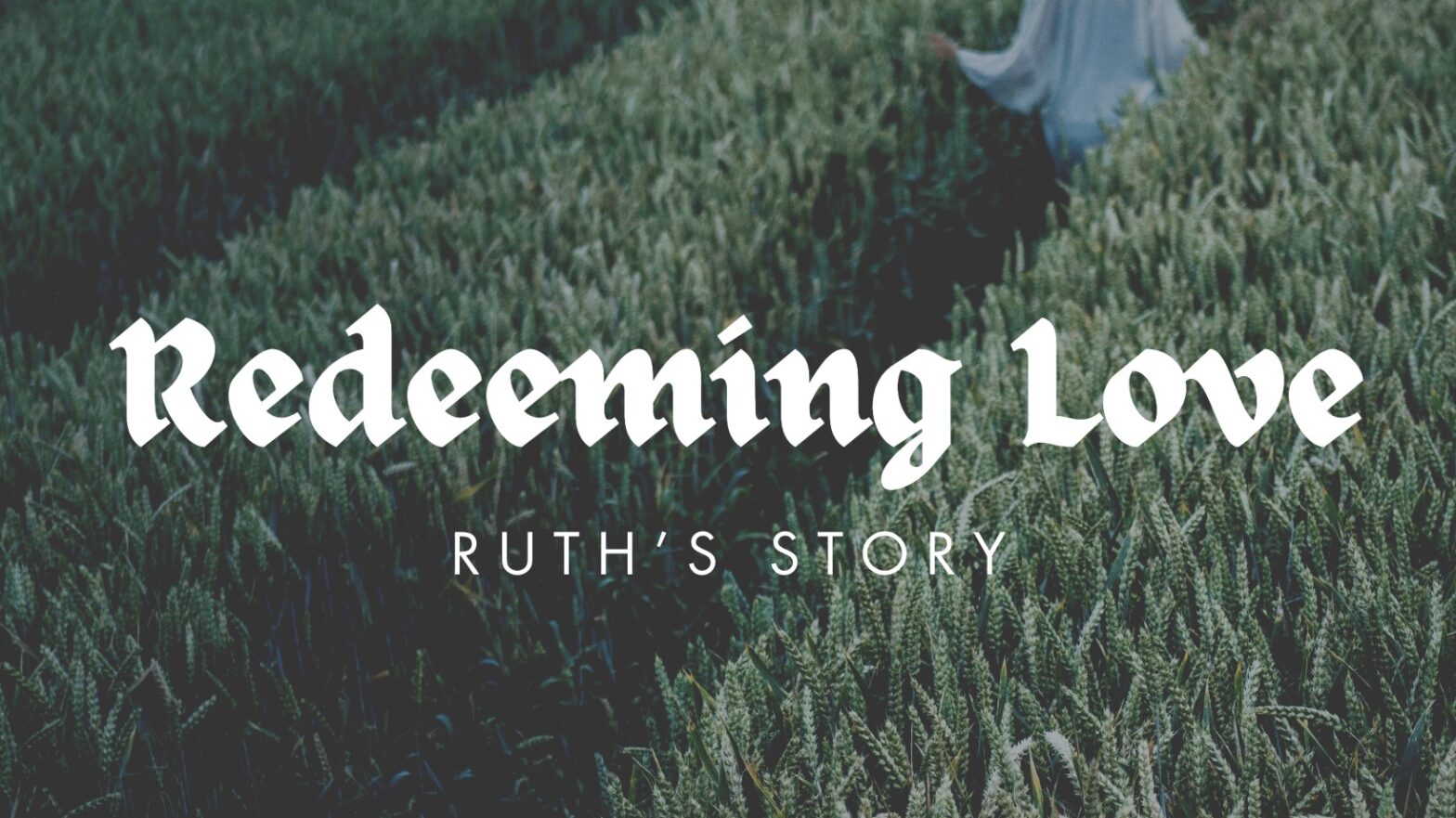The book of Ruth is a perennial favourite in women’s bible studies, retreats and devotional material. Much of it unfortunately preaches a gospel of prosperity though – “go find your Boaz” and other similar summaries abound. Is Ruth really about a harvest-time romance? Or is there more going on in this ancient tale?
Our immigrant church recently had the joy of preaching through Ruth’s story over 4 weeks. What we found was a timeless immigrant story that showed God’s redeeming love through the faith of courageous individuals. Naomi follows her family to the fields of Moab but experiences tragedy and bitterness. Ruth, her Moabite daughter-in-law, has never been to the “Promised Land” but by faith courageously cleaves to Naomi (1:14) as they return to Bethlehem (literally “the house of bread”). Back here, Ruth chances upon the field of Boaz while gleaning for food to survive. He invites her to “stick closely” or “cleave” to his workers in the harvest field for blessing and protection (2:8, 2:21). After the harvest, Naomi actively seeks for an opportunity to provide “rest” for her daughter-in-law (3:1), Ruth daringly proposes marriage to Boaz in the night, and he swiftly becomes their willing guardian-redeemer at great cost to himself. The author concludes with the women of Bethlehem praising God for providing Naomi with a grandson and not bringing her family line to “rest” (4:14). The rest is “His story”….
While Ruth is a great book that explores themes like suffering, faithfulness, love and the immigrant experience, reading it again reminded me how God’s redemptive plan for his people ultimately comes through Christ our “guardian-redeemer” – someone willing to cling to us with loyal love through his death and resurrection for our sins.
In preparation for the series, I appreciated reading Ruth in Biblical Hebrew alongside two gifted sisters (both starting / finishing their PhDs and very sharp thinkers when it comes to the world of Old Testament and Hebrew!) On the text itself, there are lots of helpful guides out there including fellow alumnus Peter Lau’s NICOT volume on Ruth published this year. I found the most practical for preachers was Teaching Ruth and Esther: From Text to Message by Christopher Ash (from the Proclamation Trust series).
For preachers, bible study leaders and keen readers, here’s a few thoughts on preaching Ruth from the Hebrew text in no particular order:
- Firstly, you can do it! If you’ve completed an introductory Biblical Hebrew course (e.g. Daily Dose of Hebrew’s free lessons keyed to Mark Futato’s grammar), recently or in the distant past, Ruth is a very suitable book to see first-hand the value of translating and teaching from the Hebrew text. It’s a biblical narrative with lots of first-year Hebrew vocabulary, the story gives you lots of practice with feminine parts of speech and word forms, and there are plenty of exegetical payoffs. For the less-confident and rusty (like me!), there are plenty of language-related helps out there from the likes of Aleph with Beth (free), Lingua Deo Gloria (free) and GlossaHouse (paid) to help you enjoy Ruth in the brilliant colours of Biblical Hebrew.
- While Christians typically assume Ruth to be one of the “historical books”, this is an unfortunate result of the canonical tradition inherited from the Latin Vulgate. The earliest Hebrew manuscripts placed Ruth not between history books like Judges and 1 Samuel, but alongside Lamentations, Esther, Ecclesiastes and Song of Songs (as the five Megillot or “scrolls”), and adjacent to other wisdom literature like the Psalms, Proverbs and Job. That’s good reason to preach Ruth as wisdom narrative (like Esther and Job).
- Contrary to the stereotypical view of Ruth’s story, the only mention of “love” in the Hebrew text is in the final verses when the women praise Naomi for her daughter-in-law, “who loves you…” (4:15; the phrase “made love” in the NIV translation of 4:13 is better translated as “they came together”, e.g. NRSV). The greatest love story in the book of Ruth isn’t a romantic or sexual love between a man and a woman: it’s the loyal love between a mother and her daughter-in-law. This fact alone should reframe how we present this book to our sex and relationship-obsessed world. Ruth has much to offer to both married and unmarried, both young and old.
- Needless to say, it’s therefore a wrong turn to present Ruth as a “how-to” on dating and romantic relationships. Despite the well-intentioned hopes of church members keen to set up “Ruths” in their church with guys like “Boaz”, unless you live in the time of the judges and live in a family clan that obligates you to ancient Near Eastern customs of levirate marriage (e.g. Genesis 38) and Israelite property redemption (e.g. Leviticus 25:25), what’s described in Ruth should not be prescribed without first considering what the text actually says. The fact is that Boaz (an older man based on how he describes everyone in his field as “young man” or “young women”) explicitly states his reason for marrying Ruth twice: “to maintain the name of the dead [Elimelek, Naomi’s former husband]… so that his name will not disappear…” (4:5, 4:10). Consider too that the climax of the story isn’t Ruth’s wedding: it’s King David’s family tree and the greater blessings that come from his royal line.
- Rather, having spent a fair bit of time in the book of Job previously, I found it especially comforting personally and pastorally helpful to read the book as “Naomi’s story”, and to consider this book as the Bible’s feminine counterpart to the book of Job. No story of suffering is identical, yet I don’t think it’s a stretch to draw connections between Naomi and Job: both share stories of suffering and bitterness, and both end with restoration and redemption, and the main protagonist gaining a renewed vision of the LORD. The book of Ruth is far richer taught as a story of redeeming love amidst great suffering than a saccharine “boy meets girl” adventure.
- On structuring a sermon series, the traditional chapters work well. I found it interesting how each chapter features a particular posture: there’s a lot of “walking” in chapter 1, lots of “coming” / “going” in chapter 2, lots of “lying” / “lying down” in chapter 3, and lots of “sitting” in chapter 4. The author seems to invite us to view Ruth’s story as poetry in motion, over four parts.
- There’s a beautiful symmetry to the story that’s worth highlighting as you travel through the book. Ruth 1 and 4 bookend Naomi’s narrative arc, and emphasise her story arc from bitter and broken after a decade of loss in the “fields of Moab”, to full and satisfied after returning to the land of God’s promises. It’s also worth contrasting Ruth 2 and 3: in one chapter the scene describes immediate provision and loving-kindness out in the open field, the next scene shows the offer of permanent provision and loving-kindness in the more intimate space of the threshing floor.
- While most of God’s activity is implicit, the author explicitly highlights the LORD’s sovereign hand twice: at the start, when He “visits his people” with food (1:6), and at the end when he brings a miraculous conception to a previously childless woman (4:13). Both are wonderful gospel themes fully expressed in the incarnation of Christ, who visits us in the flesh through a miraculous conception to the virgin Mary (Matthew 1:18-25).
- The author repeats a number of Hebrew words that serve as key themes of this book. For example: 1) the word שׁוב (“turn”, “return”) punctuates the opening chapter 11 times as Naomi struggles with which way she and her daughters-in-law should “turn” in the opening episode; 2) the word חֵן (“favour”, “grace”) occurs 3 times and all in chapter 2 to emphasise that is exactly what Naomi and Ruth find when they return to the land of promise.
- Other thematically significant words and ideas include דבק (“stick closely”, “cleave”; 1:14, 2:8, 2:21), חֶסֶד (“loving kindness” / “loyal love”; 2:20, 3:10), and the idea of rest (מָנ֖וֹחַ in Ruth 3:1, הִשְׁבִּ֥ית in 4:14). My favourite Hebrew language insight is that Boaz’s desire to “to raise up” descendants (לְהָקִ֥ים in Ruth 3:5 and 3:10) is the same root word Job uses to express his hope for a Redeemer who will “arise” or “stand” upon the earth (יָקֽוּם in Job 19:25). This “resurrection” hope becomes a reality when King Jesus walks the earth, goes to the cross, lies in the tomb, and finally sits at the right hand of God. The gospel, too, is poetry in motion from a Redeeming Love who was “raised for our justification” (Rom. 4:25).
- The variety of themes in the book of Ruth means it’s possible to preach Christ from the book of Ruth in a number of ways each time. Of course, the genealogy that closes the book can simply be extended further via Matthew 1 to show Jesus as the ultimate King that Ruth’s redemption leads to. But there is also: 1) the theme of immigrating physically (and spiritually) to God’s promised place in chapter 1, and the necessity for us to “turn” to God’s promises and cling to Him by faith; 2) the theme of finding a redeemer in God’s promised place in chapter 2, and the possibility of a greater redeemer than Boaz; 3) the intimacy of the marriage and redemptive proposal in chapter 3, and the greater union we that’s been promised to us through the new covenant that Christ proposes (and completes!) for His beloved Bride, the church (c.f. Eph. 5:31-32); 4) the costly sacrifice that Naomi and Ruth’s redemption requires (the loss of Boaz’s estate), which is a great opportunity to preach the infinitely costly sacrifice God the Son made on the cross for our sins.
Our church considered Ruth over 4 sermons. If you’re interested, you can also listen to and download them on Spotify, Apple and elsewhere.




